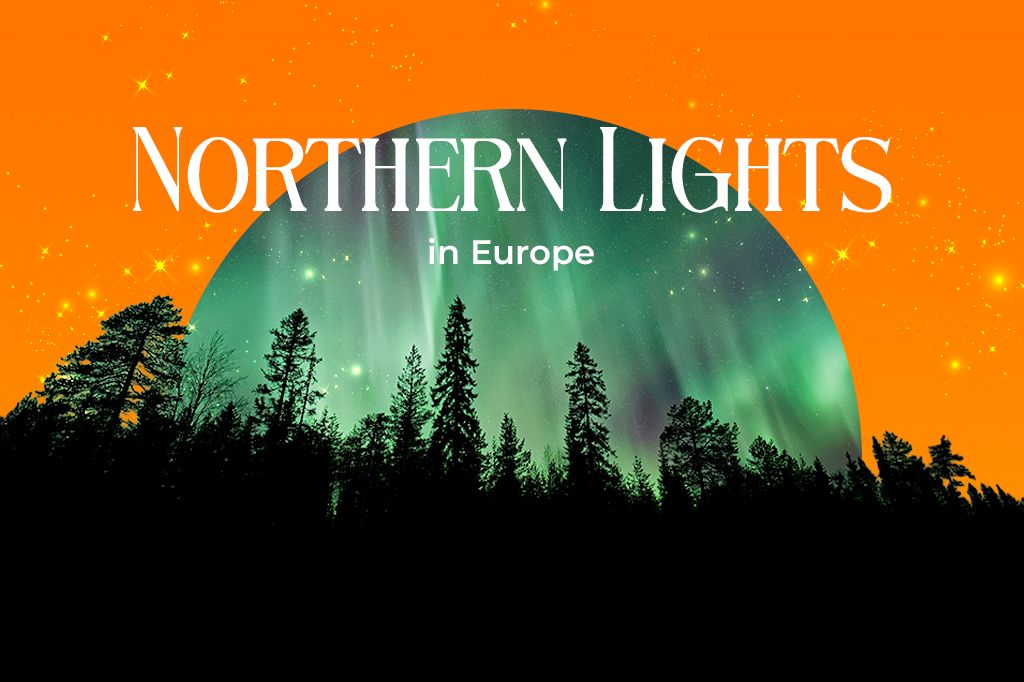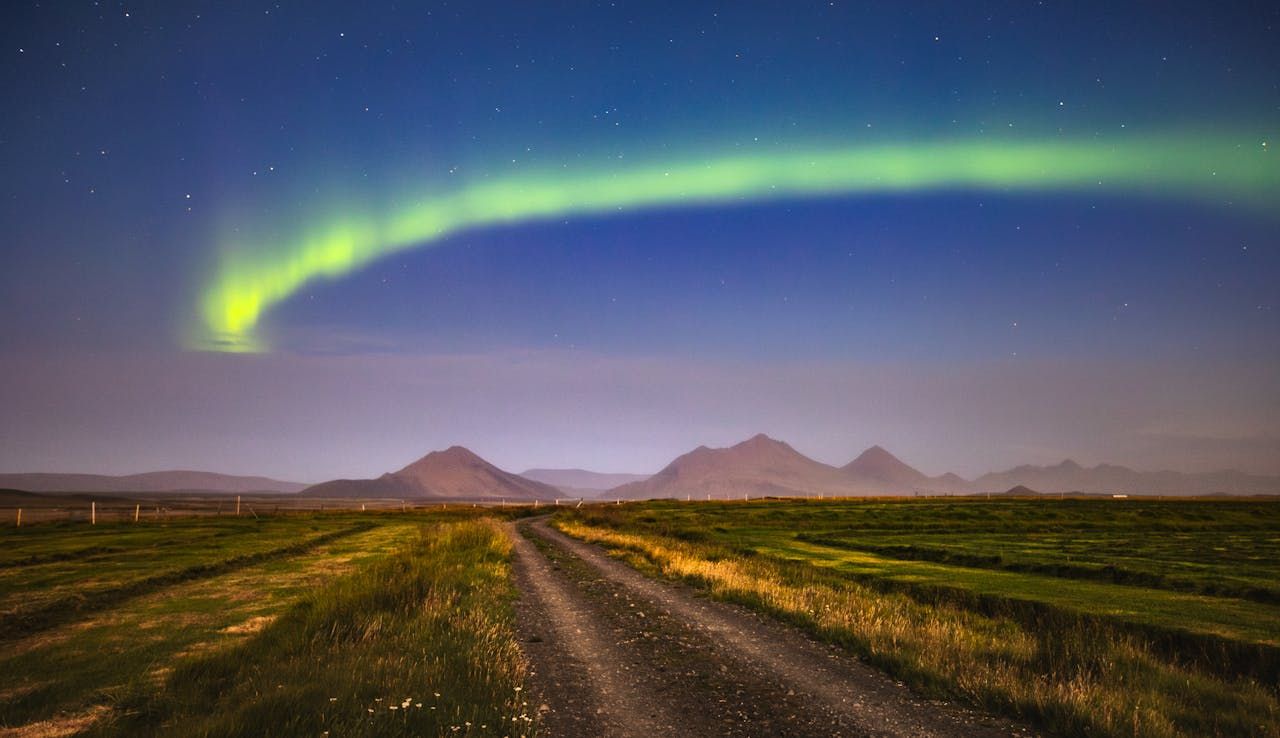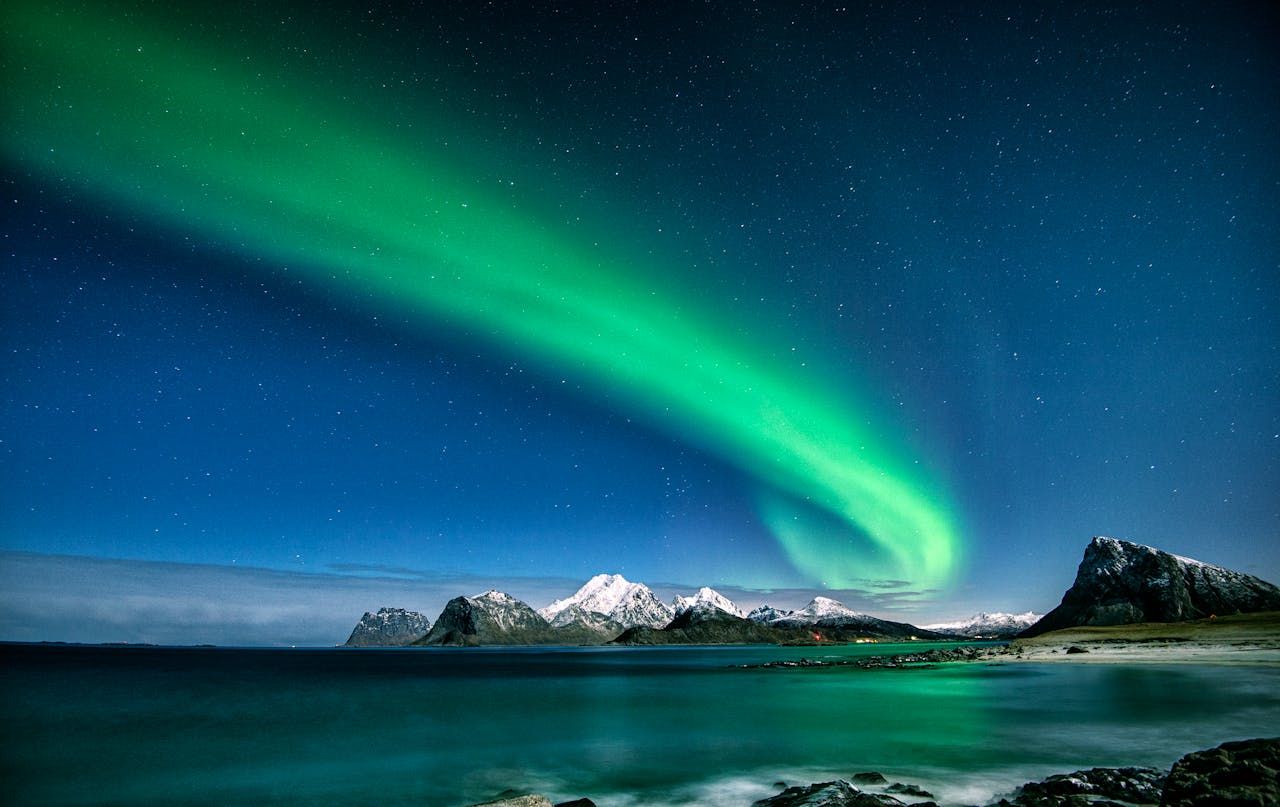There’s something otherworldly about the northern lights. Watching glowing waves of green, pink, and purple dance across the Arctic sky is one of the most magical experiences on Earth, and in 2025, your chances of seeing them in Europe will be better than ever.
In this guide, we will help you understand why this year is a once-in-a-lifetime opportunity to see the Northern Lights in Europe and how to make the most of it.

Picture by Vincent Guth on Unsplash
The Science and Mystery Behind the Northern Lights
The aurora borealis, or northern lights, is a natural light display caused by the interaction between charged particles from the Sun and atoms and molecules in Earth’s upper atmosphere, mainly near the polar regions. The Sun constantly sends out a stream of tiny, charged particles called the solar wind into space.
When some of those particles interact with Earth’s magnetic field, which acts like a protective bubble deflecting most of the solar wind, they can spiral along magnetic field lines toward the polar regions. There, in the upper atmosphere, they collide with gases like oxygen and nitrogen. These collisions release energy as light, and that’s what we see dancing across the sky in streaks of green, pink, red, and even purple.
Think of aurora-hunting like fishing during high tide. When the tide is in, fish are more active and easier to catch. The same goes for the aurora: when solar activity is high (like during the solar maximum), your chances go way up. But even with perfect conditions, there are no guarantees. You still need:
- A dark, cloud-free sky
- A spot away from city lights
- Some luck and patience
However, the Sun doesn’t always behave the same way. It goes through a natural 11-year cycle of calm and stormy periods. When it’s at its most active, we call it the solar maximum. During this time, the Sun sends out more solar flares and energy, which leads to more intense and frequent auroras on Earth.
2025 is expected to be the peak of the current solar cycle. That means more charged particles hitting Earth, brighter auroras, and better chances of seeing them even in places farther south than usual. If seeing the northern lights is on your bucket list, 2025 might just be your best chance in over a decade.
Let’s debunk common myths
There’s a lot of hearsay when it comes to the Northern Lights. Let’s set the record straight:
Myth: You can only see the northern lights in winter. Truth: It’s not related to cold, but to darkness. You can start seeing them as early as late August and into early May, as long as the skies are dark enough.
Myth: You’ll definitely see them every night in Iceland. Truth: Even in places like Iceland or Norway, seeing the aurora depends on a mix of solar activity, clear skies, and low light pollution. Some nights, the sky may stay completely still.
Myth: The northern lights are always green. Truth: Green is the most common, but depending on which gas is hit and how high up it happens, you might also see red, blue, or purple.
Myth: Auroras change the weather. Truth: They happen way above where weather forms, so while they light up the sky, they don’t affect your forecast.
When to Go for the Best Chance of Seeing the Lights
To catch the northern lights, your chances depend on a mix of long nights, clear skies, and high aurora activity. December or March are the best times of year to see them as they offer long hours of darkness and frequent geomagnetic storms.
-
December has the least daylight (around 5 hours), giving you a big window of night sky.
-
March has slightly more daylight (about 11 hours), but it often scores high on aurora activity and has less cloud cover than December.
The best shot is at night, between 9 p.m. and 2 a.m., when the sky is darkest and the Earth’s magnetic field tends to be most active.
Apps like My Aurora Forecast, Aurora Alerts, or Hello Aurora can give you a forecast, but real-time conditions like local weather, clouds, and light pollution can make or break your viewing chances. Even a strong aurora won’t matter if the sky is overcast. In that sense, December and January are the cloudiest months in northern Europe, with about 70–75% average cloud cover, which can completely block the view. March is more forgiving, with around 60% average cloud cover, meaning more chances for a clear night. The moon phase is also an important factor: a full moon can wash out faint auroras, while a new moon provides the darkest possible sky.
Best European Destinations for Northern Lights
Europe has some of the world’s best places to witness the magical northern lights. Below, we explore the top spots by country, sharing what makes each unique and what to realistically expect.
Norway
Norway’s location above the Arctic Circle and its well-established tourism infrastructure make it a prime northern lights destination.
-
Tromsø: Often called the “Gateway to the Arctic,” Tromsø boasts frequent aurora displays, easy airport access, and plenty of tours designed around northern lights watching. The city buzzes with life, combining cultural experiences with nature. To really see the lights, you’ll need to head out of the city limits.
-
Svalbard: Far north and remote, Svalbard experiences polar nights from mid-November to late January, giving you prolonged darkness ideal for spotting the aurora. The untouched Arctic landscape is breathtaking. Getting there is costly and limited. Severe weather and polar bear safety concerns mean guided tours are often necessary.
-
Lofoten Islands: Known for dramatic mountains and coastal scenery, Lofoten offers darker skies than Tromsø and amazing photographic opportunities. The natural beauty complements the northern lights perfectly. However, the weather can be unpredictable, often cloudy, and winter travel between islands requires patience.
Sweden
Abisko National Park stands out thanks to a unique weather pattern called the “Blue Hole,” where a small area of clear sky often forms even when it’s cloudy nearby. This makes it one of the best places in Europe to see the northern lights.
The park has a small village with basic places to stay, an aurora research station, and some snow activities during the day. It’s quite remote, so getting there can be tricky, and the facilities are simple, something to keep in mind if you’re used to bigger towns.
Finland
Finland’s Lapland is famous for cozy northern lights experiences, especially around Rovaniemi, the official hometown of Santa Claus. But the real magic lies beyond, in quieter towns offering pristine dark skies.
-
Glass Igloos and Cabins: Watch the aurora from warm, transparent-roof accommodations, a surreal experience combining comfort and spectacle. These unique stays are pricey and book out fast. Rovaniemi itself can be crowded, with some light pollution.
-
Hidden Gems (Inari, Utsjoki): These remote areas provide some of the darkest skies and least crowded aurora spots in Europe. Limited amenities and tricky transport mean you need to plan carefully.
Iceland
Though many visitors stay in Reykjavik, the capital suffers from high light pollution, making the northern lights harder to see. For better chances, head north or east.
-
Akureyri and Egilsstaðir: These towns offer darker skies, aurora tours, and incredible landscapes like fjords for daytime adventures. Iceland’s weather is famously changeable, and winter roads can be challenging.
-
Reykjavik: Convenient but less ideal for auroras. Many tours depart from here, but success depends heavily on weather and flexibility. Expect long nights waiting for clear skies and potentially limited visibility.
Other Aurora Spots
During solar maximum years like 2025, the aurora can appear further south, opening surprising opportunities.
-
Scotland: Northern Highlands and islands like Orkney and Shetland can catch the lights during strong solar storms. Auroras are rare, faint, and often obscured by cloudy skies.
-
Estonia and Latvia: On rare, intense geomagnetic nights, coastal and rural areas here can offer dark skies for aurora watchers. Sightings are very uncommon and heavily dependent on weather and solar activity aligning perfectly.
Make Your Northern Lights Trip Unforgettable
Seeing the northern lights is magical, but to make your trip truly unforgettable, pair it with the right activities, comfortable stays, and a good plan.
-
Stay connected while you travel: Don’t get stuck without a signal in remote areas. Try Yoho Mobile’s free eSIM trial for fast mobile data in most countries. No SIM card or contract needed, just a quick setup and you’re online in minutes. If you decide to keep it, use code YOHO12 at checkout for 12% off your eSIM plan.
-
Book a night in a glass-domed cabin: Sleeping in a heated glass igloo or dome lets you watch the aurora without leaving your bed, no freezing waits outside, and no missing a sudden burst of lights.
-
Schedule a dog sledding adventure during the day: This thrilling Arctic experience connects you with local culture and fills the daylight hours with excitement while you wait for nightfall.
-
Use an aurora forecast app: Real-time apps send alerts when geomagnetic activity spikes in your area, so you don’t miss a surprise show in the sky.
-
Choose a remote location with little or no light pollution: The darker your surroundings, the better your chances. Avoid big towns, look for lodges or cabins well outside city limits.
-
Take a sauna before heading out at night: A hot sauna before going into the cold improves circulation and comfort, and many outdoor saunas offer aurora views from the steam.
-
Join a local guided tour at least once: Guides know where to go based on live weather and aurora data, and they often have access to private or off-the-beaten-path viewing spots.
-
Pack a tripod and learn basic night photography: The northern lights are hard to photograph without the right setup. A stable tripod and manual camera settings will help you capture the moment.
-
Stay flexible and ready to move: Aurora activity can shift by the hour. Keep evenings open and be prepared to drive or relocate for clearer skies.
-
Stay multiple nights: Cloudy skies or weak auroras can happen any night. A longer trip increases your odds of catching a brilliant display.
The Magic Isn’t Just in the Sky
Chasing the northern lights is not just catching a spectacular sky show; it’s about the entire experience that surrounds it. Everything that happens before, during, and even if the lights don’t appear.
Most importantly, managing your expectations and staying open to changes can transform even a cloudy night into something memorable. Sometimes, it’s the stillness, the stars, or the conversations that end up sticking with you the most.


